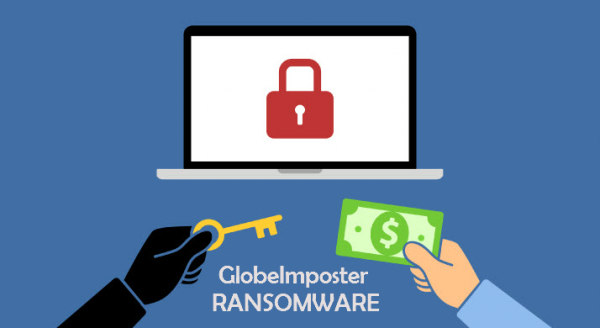GlobeImposter comes up with another spin-off. This one is true to its counterparts in most of the aspects. The only distinguishing trait is adding the ‘.726’ extension to the files affected. The users concerned also find a ransom note dropped on their devices under the following name: here_your_files!.html.

This prompts them to contact the attackers with [email protected] or [email protected]. The reply is to indicate the ransom amount payable for the decryption in bitcoins to the crooks’ wallet.
The ransomware impersonates the infection called GlobeImposter ransomware, hence its name. Both IT security and the users suffering the Imposter invasion could not quite understand why the ransomware would fake another ransomware. It is not that the original GlobeImposter virus is the most widespread or remarkably successful case. On the other hand, it has collected certain victims. It is a proven ransomware, in a way. Nobody doubts its capacity to hack computer systems and encrypt their data. That is to say, the reason why GlobeImposter tries to look like the true GlobeImposter ransomware is to convince the victims the payload it executes is a deadly one.
On the other hand, the infection actually executes its payload. The encryption wrecks the source code. The only means to undo the damage for good is the decryptor held by the crooks.
Prior to executing its encrypting payload, the ransomware needs to hop into the user’s devices. It attacks both corporate and individual machines. The attack runs through multiple spamming schemes. The malicious code lurks in the attachment the users are lured to open. The content may be tailored according to the expected profile of the recipient as the crooks widely apply target phishing.
Opening the attachment yet requires the action for the invasion to proceed. Unless you approve the execution of the on-request macro the .726 GlobeImposter cannot install.
If installed, the infection scans computer system. It detects all the available media and discards a couple of file formats. The infection aims at ensuring the system remains functional enough for the victim to read the ransom note available in here_your_files!.html. This is perhaps the only file you can read until after you get rid of .726 GlobeImposter encryption. To remove .726 GlobeImposter virus, any ransom shall not be paid. Proceed with the recovery and removal steps as outlined below.
Automatic removal of .726 File Virus
The benefits of using the automatic security suite to get rid of this infection are obvious: it scans the entire system and detects all potential fragments of the virus, so you are a few mouse clicks away from a complete fix.
- Download and install recommended malware security suite
- Select Start Computer Scan feature and wait until the utility comes up with the scan report. Proceed by clicking on the Fix Threats button, which will trigger a thorough removal process to address all the malware issues compromising your computer and your privacy.
Restore files locked by .726 File Virus
new Locky variant aka .726 File Virus represents a unique category of malicious software whose attack surface reaches beyond the operating system and its components, which is why removing the virus itself is a part of the fix only. As it has been mentioned, it encrypts one’s personal information, so the next phase of the overall remediation presupposes reinstating the files that will otherwise remain inaccessible.
-
Launch data recovery software
Similarly to the rest of its fellow-infections, .726 File Virus most likely follows an operational algorithm where it erases the original versions of the victim’s files and actually encrypts their copies. This peculiarity might make your day, because forensics-focused applications like Data Recovery Pro are capable of restoring the information that has been removed. As the virus further evolves, its modus operandi may be altered – in the meanwhile, go ahead and try this.
-
Take advantage of Volume Shadow Copy Service
This technique is based on using the native backup functionality that’s shipped with Windows operating system. Also referred to as Volume Snapshot Service (VSS), this feature makes regular backups of the user’s files and keeps their most recent versions as long as System Restore is on. 726 File Virus ransomware hasn’t been found to affect these copies therefore the restoration vector in question is strongly recommended. The two sub-sections below highlight the automatic and manual workflow.
- a) Use Shadow Explorer
Shadow Explorer is an applet that provides an easy way of retrieving previous versions of files and folders. Its pro’s include an intuitive interface where the computer’s entire file hierarchy is displayed within one window. Just pick the hard disk volume, select the object or directory to be restored, right-click on it and choose Export. Follow the app’s prompts to get the job done.

- b) Use file properties
Essentially, what the above-mentioned Shadow Explorer tool does is it automates the process that can otherwise be performed manually via the Properties dialog for individual files. This particular approach is more cumbrous but just as effective as its software-based counterpart, so you can proceed by right-clicking on a specific file, which has been encrypted by .726 File Virus, and selecting Properties in the context menu. The tab named Previous Versions is the next thing to click – it displays available versions of the file by date of the snapshot creation. Pick the latest copy and complete the retrieval by following the prompts.

-
Data backups work wonders
Ransomware like .726 File Virus isn’t nearly as almighty and destructive in case you run regular file backups to the cloud or external data media. The virus itself can be completely removed in a matter of minutes, and the distorted information can then be just as easily recovered from the backup. Luckily, this is a growing trend, so ransom Trojans are hopefully going to become less subversive in the near future.
Verify thoroughness of the removal
Having carried out the instructions above, add a finishing touch to the security procedure by running an additional computer scan to check for residual malware activity
